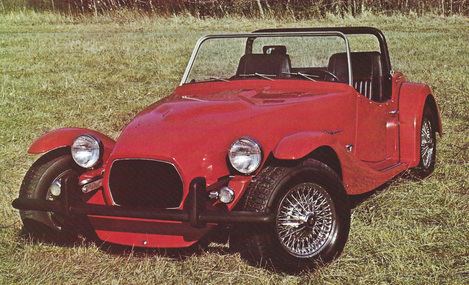 | ||
Blakely Auto Works (also called Bernardi Auto Works in later years) was a manufacturer of automobiles and of kit cars, working from premises located in a series of US midwest communities, including Princeton, Wisconsin, in the 1970s and 1980s. Blakely produced several kit car models, the Bantam, Bearcat, and Bernardi.
Contents
History
Blakely Auto was founded by Dick Blakely to market affordable sports cars in the spirit of the legendary Lotus Seven: compact, lightweight, and with excellent handling. The Bantam was Blakely's first offering. It was followed by the larger Bearcat and eventually by the Bernardi.
The founder had a degree in mechanical engineering and had been involved in oval track racing prior to designing the Bantam. His goal with the initial design was to maximize performance while minimizing size, weight, accessories, and other features that might conflict with acceleration and handling. Blakely took inspiration from an early model of the British Dutton Cars, itself a Lotus Seven replica. After building the first car for himself, Blakely found sufficient interest from other auto enthusiasts to warrant building more cars of the same design. Partnering with Denny Myelle, Blakely began to produce the Bantam as a kit and also to develop a new, larger car that was more versatile and suited to off-track use. This second model became the Bearcat and later developed into the Bernardi.
For both models, a key design goal was use of a single donor automobile. Designs based on a single donor simplify the build process. The car Blakely selected was the Ford Pinto, with the option to use parts from close relatives like the Mercury Bobcat and the Ford Mustang. This family of donor vehicles gave the Blakely cars rack-and-pinion steering, front disk brakes, and a good selection of engine choices. For the chassis, Blakely Auto provided a frame of box steel tubing, custom front upper A-arms for the suspension, new shocks, and instructions for modifying and attaching the remaining chassis components from the donor car. Blakely Auto also supplied a full replacement body, including the body tub, doors, hood, fenders, trunk, convertible or hard top, and windshield.
Around 1979, ownership of the company transferred to Art Herschberger. In the Spring of 1979 he moved production from Davis Junction, Illinois to Princeton, Wisconsin. The early 1980s saw development and production of the Bernardi, a significant modification of the Bearcat model. In 1985, the company was renamed the Bernardi Auto Works. The business appears to have shut down in the late 1980s. Blakely automobiles still appear for sale in various specialist auto markets, but no new ones are being manufactured.
